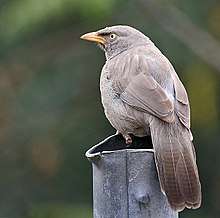Argya
Argya is a genus of passerine birds in the family Leiothrichidae. The species are distributed across Africa and southern Asia and are typically fairly large, long-tailed birds that forage in noisy groups. Members of this genus were formerly placed in the genera Turdoides and Garrulax.
| Argya | |
|---|---|
 | |
| Jungle babbler (Argya striata) | |
| Scientific classification | |
| Kingdom: | Animalia |
| Phylum: | Chordata |
| Class: | Aves |
| Order: | Passeriformes |
| Family: | Leiothrichidae |
| Genus: | Argya Lesson, R, 1831 |
| Species | |
|
See text | |
Taxonomy
| |||||||||||||||||||||||||||||||||||||||||||||||||||||||||||||||||||||||||||||||||
| Relationships between the species examined in the 2018 phylogenetic study.[1] |
Most of the species now placed in the genus Argya were previously assigned to the genus Turdoides. Following the publication of a molecular phylogenetic study in 2018, Turdoides was split and species were moved to the resurrected genus Argya that had been erected by the French naturalist René Lesson in 1831.[1][2][3] The name is from the Latin argutus meaning "noisy".[4] Lesson did not specify a type species but this was designated as the Arabian babbler (Argya sqamiceps) by the English zoologist George Robert Gray in 1855.[5][6]
Species
The genus contains 16 species:[2][7]
- Large grey babbler (Argya malcolmi)
- Ashy-headed laughingthrush (Argya cinereifrons) - formerly in Garrulax
- Arabian babbler (Argya squamiceps)
- Fulvous babbler (Argya fulva)
- White-throated babbler (Argya gularis)
- Striated babbler (Argya earlei)
- Iraq babbler (Argya altirostris)
- Common babbler (Argya caudata)
- Afghan babbler (Argya huttoni)
- Rufous chatterer (Argya rubiginosa)
- Scaly chatterer (Argya aylmeri)
- Yellow-billed babbler (Argya affinis)
- Jungle babbler (Argya striata)
- Orange-billed babbler (Argya rufescens)
- Slender-billed babbler (Argya longirostris)
- Rufous babbler (Argya subrufa)
References
- Cibois, A.; Gelang, M.; Alström, P.; Pasquet, E.; Fjeldså, J.; Ericson, P.G.P.; Olsson, U. (2018). "Comprehensive phylogeny of the laughingthrushes and allies (Aves, Leiothrichidae) and a proposal for a revised taxonomy". Zoologica Scripta. 47 (4): 428–440. doi:10.1111/zsc.12296.
- Gill, Frank; Donsker, David, eds. (2019). "Laughingthrushes and allies". World Bird List Version 9.1. International Ornithologists' Union. Retrieved 16 January 2019.
- Lesson, René (1831). Traité d'Ornithologie, ou Tableau Méthodique (in French). Paris: F.G. Levrault. p. 402.
- Jobling, James A. (2010). The Helm Dictionary of Scientific Bird Names. London: Christopher Helm. p. 55. ISBN 978-1-4081-2501-4.
- Gray, George Robert (1855). Catalogue of the Genera and Subgenera of Birds Contained in the British Museum. London: British Museum. p. 43, No. 723.
- Mayr, Ernst; Paynter, Raymond A. Jr, eds. (1964). Check-List of Birds of the World. Volume 10. Cambridge, Massachusetts: Museum of Comparative Zoology. p. 331.
- Collar, N. J. & Robson, C. 2007. Family Timaliidae (Babblers) pp. 70 – 291 in; del Hoyo, J., Elliott, A. & Christie, D.A. eds. Handbook of the Birds of the World, Vol. 12. Picathartes to Tits and Chickadees. Lynx Edicions, Barcelona.